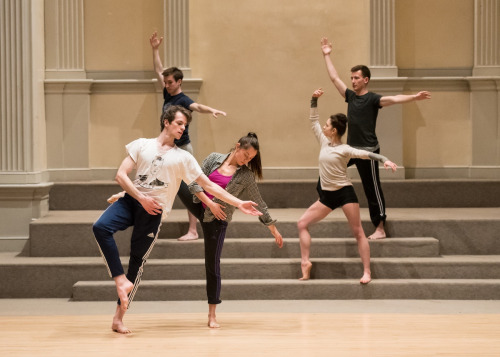“Dance in Progress”: Watching Pam Tanowitz make a dance
April 6, 2015
by Emmanuel Iduma
It is truly a revelatory act: until you feel the kick of completion, like the formation of sinews in the womb, there can be no understanding.
Meanings coagulate; a juxtaposition of disparate gestures.
The dancers know they possess the potential to alter the course of the dance. But they seem protective of their agency, with reverence to the leader who stands unassumingly before them, attentive.
No one seems ashamed of failing. In the course of their open rehearsal, they could fail, but this isn’t a thing to be embarrassed about. Perhaps perfection has its dose of uncertainty, and of dialogue tainted with pauses.
How do choreographers know it is time to stop? She knows the possibilities are infinite. Her greatest task will be to bring things to a pause, then introduce to the viewer an uncertainty; hence wonder.
Each dancer was asked to bring a movement. Hence: the material is of many origins, rich with detours.
She watches the dancers individually—understanding, as if with one glance, the limits, tendencies, idiosyncrasies, potentials of each body. She listens for their instincts, obeys them, but adds some flourish.
While asking them to move their hips repeatedly, she says: I know you’ll ask me how many times, but I don’t know.
Right legs incline upwards. Some legs reach higher than others. It could be that some of the dancers are skilled ballet dancers, or possess the spectacular intuition of gymnasts, and it could be that some aren’t as skilled. But it makes for a glamorous sight: the unevenness of similar gestures.
A young girl checks some speakers for sound. She signals to a man arched over a console. He is her father, if I have guessed correctly. Maybe Pam Tanowitz is her mother. My other guess is that something unique will emerge out of this marriage of making a dance while making music.
She says: I have to fix that. Does she see reparable gestures as one would see pixelated images?
The musician watches with his eye, but his ears are doing all the work.
It is wonderful to see people come and go. What new task do I give my eye?
The sound of counting as she teaches a new sequence was one of clicking, as her tongue repeatedly hits the roof of her mouth.
Like tap dancing, the foot touches the ground and produces a rhythmic sound. Unlike tap dancing the foot is sometimes held in a pause.
The dancers occasionally fling their socks towards the edge of the room, out of the dance space. Their warmed feet now dance bare. Imagine: the music is a ripple across the ocean, waves formed by dancing bodies.
When one of the dancers comes near me, her breath is loud and hot, as one who puffs out energy.
After each break, the dancers regroup. In the manner they assemble, the dance seems to carry a recalibrated meaning, to possess a fresh vision.
There are moments I fail to glimpse during the rehearsal, which when they unfold afterward in one of the showings, take me by surprise.



